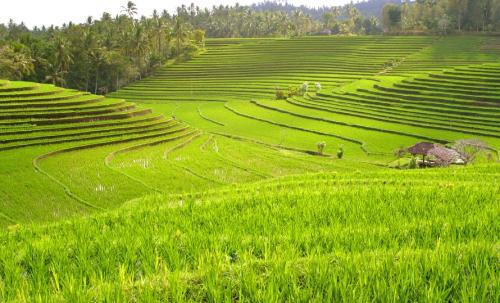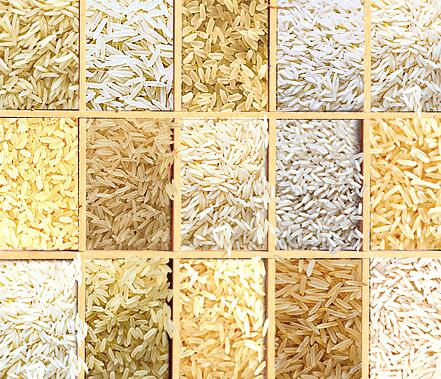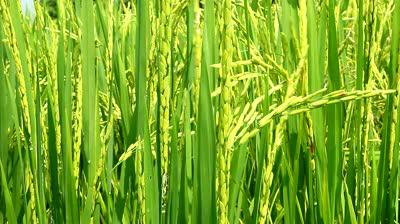Rice - one of the most valuable crops in the world, is one of the main food products for the majority of the population of our planet. This is an annual plant, a family of monocotyledonous cereals.
general information
This cereal has a fibrous root system, with airways that allow air to enter the flooded soil. Rice is a bush consisting of knotted stems, whose thickness is about 3-5 mm, and a height of 38 cm, it is also 3-5 meters high (deep-water forms). The stems are mostly erect, but there are rising and creeping. The leaf is lanceolate, the inflorescence is a panicle, the length of which is 10-30 cm. The panicle is compressed or spreading, hanging or upright, depending on the rice variety. A large number of one-flowered spikelets on short legs are located on it. Whole, ordinary rice grain consists of a hard shell, under which the brownish-colored grain is located. Under the peel is the endosperm, the most nutritious part of the grain, and we see it in the form of white rice, called polished or polished. About 94% of it contains starch, about 6-10% of protein, but, unfortunately, it has almost no B vitamins and minerals. Polished rice cooks faster, easier to absorb by the body. In hot humid climates, the product is stored longer.

Rice growing
There are 3 types of fields on which this cereal is grown: dry, checks and estuary. On the fields of checks, the technology for growing rice consists in growing with constant flooding until the crop ripens, then they drain the water and begin to harvest. This type of harvesting is the most common, so they collect about 90% of the world's rice production. Dry land fields are located in areas where there is a large amount of rainfall, so they do not require artificial irrigation. On those and other fields you can grow rice of the same varieties, but the yield on the fields of checks is higher. The estuary rice field is mainly located in floodplains and is cultivated during floods. In this case, they use rice of a special variety, with a fairly fast-growing stem, whose panicles float on the water. Compared to growing rice in other fields, this method gives a much smaller yield, but it is more traditional for those regions where cereal is the most important nutrient for the population, for example, in Asia.

Types of rice
Thousands of different rice varieties exist in the world. For example, in Asia, each field gives its own variety of this culture. It is classified by grain length, type of processing, color, flavor. According to the degree of processing, the cereal is divided into white rice, brown and steamed.
The following types of rice are distinguished:
- Paddy: Unbroken rice just brought back from the field can be stored for several years.
- Rice husk - removing it from grain is the first stage of processing, used as animal feed and as fertilizer.
- Bran shell: it is obtained in the process of grinding grains, used for cooked breakfasts and animal feed.
- Polished white rice: the most common. There are round-grain, medium-grain and long-grain rice, photos of which can be seen in the article.
- Steamed rice: Unbroken rice is pre-soaked in water and then steamed under pressure.
- Brown or unpolished. There are medium- grain and long-grain rice, the price of which is not much different from the price of polished rice, but is considered much more useful than white rice.
- Broken rice: during processing, rice grains break, large pieces are used for confectionery and breakfast, small ones - for rice flour.
- Rice types such as jasmine, basmati, Egyptian and wild are also common.
History and distribution
For about 7 thousand years, people eat and grow rice. Photos showing this can be found in ancient manuscripts of China and India. Even then, in the rice fields, a canal system was used to irrigate this crop. Where he first appeared is not established, but some scholars agree that India is considered his homeland. According to other sources, rice fields in China appeared as far back as 5 millennium BC and approximately by 500 BC were already located in Southeast and South Asia, China and India. Spreading, this cereal adapted to different weather conditions, for example, in South Asia, a large amount of water and heat was needed all year, and in Japan, Korea and central China, varieties that tolerate cold and which need a little water were introduced. In Asia, rice is still harvested and planted by hand, it has been grown for centuries on mountain plateaus, hillsides and small patches of land. In the 13th century, rice fields appeared in Sicily, in North America it turned out to be along with the French, British and Japanese. Portuguese and Spaniards brought rice to South America. Rice cultivation in Russia began more than 300 years ago.

Rice in Russia
In the Russian Empire, the first rice field appeared during the time of Ivan the Terrible. A decree was given to the Astrakhan governor for the cultivation of "Saracen millet", that is what rice was called then. Fields are located in the lower Volga, but the result of the experiment, unfortunately, remains unknown.
Under the reign of Peter I, “Saracen millet” arose again in Russia, it was sown in the Terek River Delta , and the fate of the crop was again lost among urgent state needs. And only in 1786, rice reappeared on the territory of Russia, - was brought by the Kuban Cossacks. Rice fields are located in the floodplains of the Kuban River, and after receiving a good harvest, rice fields arose in Russia.
Rice consumption in the world
There are 2 approaches to the consumption of this cereal: “western” - typical for the countries of America and Europe, and “eastern” - for the countries of Asia. In eastern countries, rice is a daily food item; in Europe, rice got its fame later, and initially it was an exotic plant and was prepared exclusively for the holiday menu. Over time, rice has also become one of the main foodstuffs, but, unlike in Asian countries, rice began to be cooked in Europe with poultry, meat, seafood and spices.
The need for rice culture
About 350 million tons of rice is produced annually on Earth. More than half the people on the planet consume it 3 times a day. And in Japan, 78% of peasant farms are directed to rice cultivation, for example, although the cost of rice is much higher here. The consumption rate of this cereal per person in Asia is 150 kg per year, and in Europe - 2 kg per year. About 12-13 million tons is the annual volume of world imports and exports, that is, approximately 4% of the total crop on Earth. South America and Asia are the main exporters of rice, and Europe is the importer.
Rice sowing
For seed cleaning, special sorting separators are used, then the seeds are checked for germination, with indicators less than 90% of the grain are considered unsuitable. 5-8 days before sowing, the seeds are dried in the sun, soaked in warm water for 2-3 days, after swelling, dried to flow and begin to sow in preheated soil up to 10 cm deep. Narrow-row disc seeders are considered the best way to plant rice with flanges or ordinary privates. The cross-diagonal method of sowing rice brings good results. In flooded soils, spreading sowing from an airplane is used, so you can sow about 150 hectares per day with one airplane. Rice can also be grown from seedlings. This method is used in Vietnam, China, Japan and other countries. Seedling culture in the CIS countries is found in Azerbaijan.
Rice crop irrigation and care
There are 3 ways to irrigate rice crops:
- permanent flooding - water on the field is throughout the growing season;
- shortened flooding - at the beginning and at the end of the growing season there is no water layer;
- intermittent flooding - the water level is maintained for certain periods.
In CIS mills, mainly shortened flooding is used. On soils that are not very saline and relatively clean from weeds, watering is carried out after sowing and before germination. After sprouting, the rice field is poured, and a not very large layer of water is left during tillering - about 5 cm. Then, a little layer of water is increased to 15 cm, and at this level the water is until the plants ripen. Over time, the water supply is slightly reduced so that the earth dries up to ripen, and you can start harvesting. To destroy algae, chemical weed control or airing the soil, the rice field is dried. A photo of this procedure can be found in many recommendations for irrigation and rice care.
Rice cultivation technology
The All-Union Research Institute of Rice has developed rice cultivation technology, thanks to which it is possible to obtain from 4 to 6 tons of grain per 1 ha. The technology is calculated taking into account the specifics of soils, climate features, varieties.
For the southern regions and the Krasnodar Territory, 8 options for the production of rice culture technology have been developed:
- The basic technology, which includes 66 operations, is accompanied by high rice productivity, high fuel consumption and high labor intensity.
- A technology in which seeds are sown to a depth of 4 or 5 cm and includes 49 operations. Here, preliminary soil preparation is used: autumn planning and early plowing.
- A technology in which soil processing operations are combined: leveling the microrelief, using mineral fertilizers and herbicides, sowing, rolling the surface.
- The technology, which provides for minimal tillage: it does not include operations such as plowing, disking, chiseling, operational planning, plowing.
- A technology specialized in checks filled with water, that is, where the rice field is not possible to dry in spring and autumn, as well as in rainy times during sowing and soil preparation.
- Herbicide-free technology that allows agronomic techniques to combat weeds, diseases and pests.
- Pesticide-free technology for growing diet rice.
- A technology where all energy-intensive and labor-intensive technological processes are performed by KFS-3.6 and KFG-3.6 aggregates and a PR-2.4 rotary plow. A distinctive feature of the method is smooth plowing.